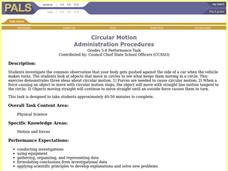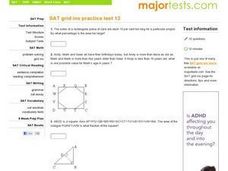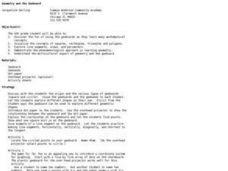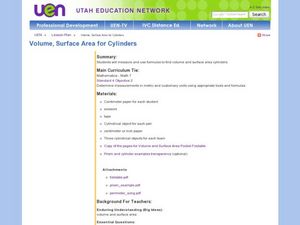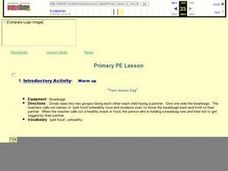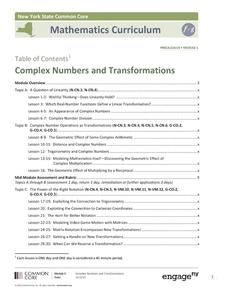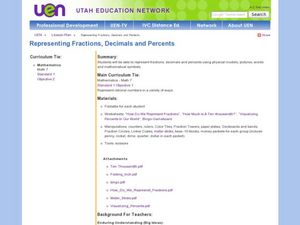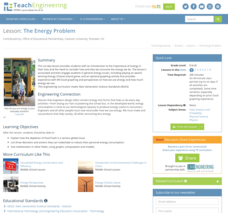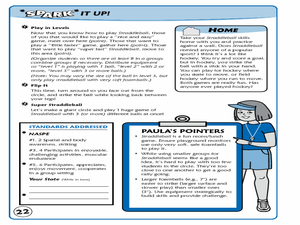Curated OER
Proper Nouns
Use this worksheet to help your class identify proper nouns. They circle the proper nouns in 16 sentences. Answer key is provided.
Curated OER
Biology - Life Cycles Game
High schoolers develop a working vocabulary of terms related to the life cycle. In small groups, students play the life cycle's game which consists of matching and defining vocabulary. Directions for creating the game board are...
Curated OER
Circular Motion
Students investigate circular motion in two different activities. In the first, students observe the path of a rolling marble on a paper plate. In the second, students play a game of catch using a tennis ball inside a plastic bag. ...
Curated OER
SAT Grid Practice Test 12
In this SAT practice test, students solve various problems dealing with percent, area of polygons, rates, functions, and distance. This one page on-line worksheet contains ten multi-step problems.
Curated OER
Organizing Data
In this organizing data worksheet, 7th graders solve seven different types of problems related to data. They first identify the type of data as categorical, discrete or continuous from the information given. Then, students use Excel to...
Curated OER
Geometry and Geoboard
Sixth graders use geoboards and dot paper to experiment with geometric concepts. In this geometry instructional activity, 6th graders complete four activities using geoboards or dot paper including naming points on a coordinate plan and...
TRAIN Educational & Community Services
Multicultural Activities
From catching stars developed by African pygmy tribes to chop stix pick-up or the Hanukkah dreidel, use this list of diverse multicultural activities to help your learners draw connections to unique cultures of the world.
Curated OER
Volume, Surface Area for Cylinders
Seventh graders explore the concept of volume and surface area of cylinders. In this volume and surface area of cylinders lesson, 7th graders break cylinders into their base shapes of a circle and a rectangle. Students discover that...
American Farm Bureau Foundation for Agriculture
Shapes in Agriculture
It's time to get crafty with shapes! Your future farmers demonstrate their geometric ability by building a farm using triangles, circles, rectangles, and squares. But first, scholars take part in a brainstorm session inspired by their...
National Park Service
Subalpine Web
The theory of keystone species in an ecosystem was first established in 1969 by Robert T. Paine. Pupils open the final lesson in a five-part series with a game guessing which member of the alpine ecosystem they are based on clues. After...
Curated OER
Primary PE Lesson
Students work on balance, strategy, and movement while playing a beanbag game. They review high fat and low fat foods and classify these foods while they play a game of "Low Fat Locomotion."
Curated OER
Oil Search
Students participate in a mock oil search game and attempt to find "oil" in a model oil field. They drill initially based on random guessing, but each time they drill they use prior knowledge to determine where to drill next. They must...
EngageNY
Complex Numbers and Transformations
Your learners combine their knowledge of real and imaginary numbers and matrices in an activity containing thirty lessons, two assessments (mid-module and end module), and their corresponding rubrics. Centered on complex numbers and...
Curated OER
Boccia
Boccia is very similar to the game of bocce. There is a jack, a small ball that is tossed within a 12' x 6' area which becomes the target. Each team has six hand-sized leather balls which they try to get as close as possible to the jack...
Illustrative Mathematics
Shape Hunt Part 2
Shapes are everywhere in the world around us, from rectangular doors to the circular wheels of a car. The second lesson plan in this series opens the eyes of young mathematicians to this wonderful world of shapes as they search the...
Curated OER
Triple Pin Soccer
Triple Pin Soccer promises to be a fast paced, high action game, especially if there is more than one ball in play. The players have an opportunity to score in three different goals while protecting their own. Looks like it's going to be...
Colorado State University
Why Do Hurricanes Go Counterclockwise in the Northern Hemisphere?
Test your class' coordination as they model the Coriolis Effect. Forming a large circle, learners move to the right as they try to toss a ball to the person across from them. The movement of the circle represents the rotation of the...
Curated OER
Representing Fractions, Decimals, and Percents
In this fractions, decimals, and percents lessons, students explore various methods of representing fractions. They demonstrate situations that represent rational numbers. Students create a foldable exploring fractions, decimals and...
Curated OER
Fitness for Life - Rocks n Hoops
A game of tag, and stealing, in which all of your class can participate actively in. This activity requires team work and cooperation while being competitive. There are suggestions to keep the game moving, and to modify it to make it...
Teach Engineering
The Energy Problem
Think you can solve the energy problem? You'll first need to know about current energy use. Analyzing a set of circle graphs lets scholars see where energy consumption is the greatest, both by sector and by household use. They develop a...
Gatton Park
Magical Maths
A variety of activities take scholars outside the classroom to explore shapes, symmetry, measurement, patterns, sorting, and time in nature. Learners participate individually, and in teams, to measure found objects, go on a scavenger...
Curated OER
Straddleball
Students play a game. In this spatial and body awareness lesson plan, students play a game called straddleball. Students practice throwing a ball, being spatially aware and playing a game with good sportsmanship.
Curated OER
Running Colors
Students play a game with mats of different shapes and colors spread out over a playing area. As a shape and color is called out students run the the corresponding mat and stand on it.
Curated OER
Graphs, Stories, And Games
In this graphs lesson, students read stories and present story situations on a graph. They explore distance and diameter and explain graphs. Students create their own stories to fit graphs.




